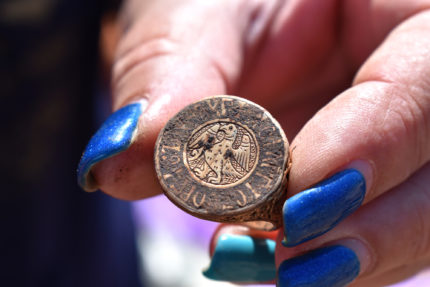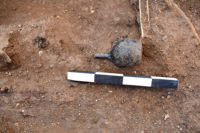 Bulgarian archaeologists have discovered the tomb of a 14th-century aristocrat from the Byzantine Palaiologos imperial dynasty at the Kaliakra Fortress in northern Bulgaria. The tomb’s occupant was identified by a gold signet ring inscribed with his name: Georgi Palaiologos.
Bulgarian archaeologists have discovered the tomb of a 14th-century aristocrat from the Byzantine Palaiologos imperial dynasty at the Kaliakra Fortress in northern Bulgaria. The tomb’s occupant was identified by a gold signet ring inscribed with his name: Georgi Palaiologos.
The ring is of the Kaloyan type, named after the gold seal ring found in a grave near the Church of the Holy Forty Martyrs in Tarnovo that was associated with the late 12th century Bulgarian Tsar Kaloyan but almost certainly belonged to a 14th century descendant with the same name. Georgi’s ring is much more impressive than Kaloyan’s, larger, heavier with more detailed engraving. The central image is a dove with a cross-hatched background. The inscription encircles it.
In 16 seasons of excavations, numerous burials of Kaliakran aristocracy have been unearthed at the fortress on the coast of the Black Sea. It was the capital of the Despotate of Dobruja in the 14th century, ruled by Balik, followed by his brother Dobrotitsa. They were allied to the Palaiologi. Balik supported Anna of Savoy, widow of Emperor Andronikos III Palaiologos and regent for her minor son John V Palaiologos during the Byzantine civil war (1341–1347). After Balik’s death in 1347, Anna carved out a larger autonomous province for Dobrotitsa to rule and he ended up conquering much of Bulgaria. Dobrotitsa’s daughter (we don’t know her name) married Michael Palaiologos, son of John V. It’s therefore eminently possible Georgi was related to both the despots and the emperors.
In the grave, the archeological team uncovered rich gifts that made it possible to restore the ritual of sending the young dead. The funeral was carried out in the second half of the fourteenth century, with a pit formed on a rock with a stone enclosure. The nobleman was laid in a coffin with well-preserved traces. His face was covered with luxurious fabric, gifts and a glass vessel were placed on his body, in which, according to his beliefs, the tears of the mourners were collected.
 Note to self: add a mourners’ tears goblet codicil to my will.
Note to self: add a mourners’ tears goblet codicil to my will.
This year’s dig will conclude at the end of the month. Later this year the National History Museum in Sofia will publish the full catalogue of finds from 2018’s star discovery, the clay pot full of coins, jewelry and other valuables dubbed the “Tartar booty.”
Cool ring Disgusting nails!
Mark, I was thinking “incongruous” but you nailed it, so to speak.
The central device looks more like a heraldic eagle than a dove to me. The hooked beak is a give away. Maybe something got lost in translation from Bulgarian to English.
Indeed, I would agree to the eagle, but maybe Georgi was a bit ..special. The Greek plural would rather be ‘Palaiologoi’, wouldn’t it? :hattip:
—-
Giovanni Palaiologos was killed in the Battle of Naseby, remarkably fighting in the English Cicil War against his own brother Teodoro Palaiologos. Yet another brother was buried in Barbados: “Here Lyeth ye body of Ferdinando Paleolocus descenden from ye imperial line of ye last christian emporers of Greece, churchwarden of this parish 1655 – 1656 vestryman twentye years died October 3, 1678”.
Ferdinand Palaiologos too had been a soldier, but he emigrated to Barbados in the West Indies before the Civil War broke out. He acquired a small landed estate there, married Rebecca Pomfrett and had one son named Theodorious. His will survives, dated September 1670. He was long remembered on Barbados as ‘the Greek prince from Cornwall’.
—-
Of course, the Byzantine civil war of 1341–1347, rebellions followed by the Third Palaiologan Civil War of 1373–1394, were not entirely helpful, in order to keep the Turks in Central Asia. Arriving Turks had colonised the land via a mix of conquest and trade. In the 1360s, the Turks continued to drive through Thrace, taking Byzantine, Bulgarian and Serbian settlements. Bayezid’s siege to Constantinople began in 1394.
A massive counter-attack by the West was to be launched as the Crusade of Nicopolis. Bayezid force-marched his army to a stunning yet costly victory. Thousands were killed, but Bayezid would soon be able to turn his armies fully against Constantinople. The Battle of Nicopolis (Битка при Никопол, Turkish: Niğbolu Savaşı, Hungarian: Nikápolyi csata, Romanian: Bătălia de la Nicopole) took place on 25 September 1396 and resulted in the rout of an allied crusader army of Hungarian, Croatian, Bulgarian, Wallachian, French, English, Burgundian, German and assorted troops, assisted by the Venetian navy, sealed the end of the Second Bulgarian Empire.
A Bavarian teenager by the name of Johann Schiltberger had been lucky to keep his head onto his shoulders, as he got enslaved by Bayezid [Bayezid I]. In his own records, he describes ‘Kallakrea’ [Kaliakra, our fortress] as the capital of the ‘Third Pulgrey’ [Bulgaria], ‘do die Thonau in das mer fleust’ [i.e. into the Black Sea]. The conquest of Constantinople followed a seven-week siege which had begun on 6 April 1453. However, Schiltberger outlived Bayezid, changed several heands and countries like Arabia and Egypt, and still had managed to return to Bavaria by 1427 [i.e. after 32 years], where he passed away a couple of years later around 1440.
It was quite some time, therefore, until in 1453 finally Byzantion/ Constantiople fell among the Turks. Schiltberger had made it to a still Byzantine Constantinople, and got a shipment back to Bulgaria, this time Kilija [today in Ukraine], and obviously he had made it back to Bavaria from there. Schiltberger is perhaps the first writer of (Western) Christendom to give the true burial place of Muhammad at Medina: His sketches of Islam and of Eastern Christendom, with all their shortcomings, are of remarkable merit for their time.
Seems like everywhere people dig they find those black and white things. Wonder what they are!?